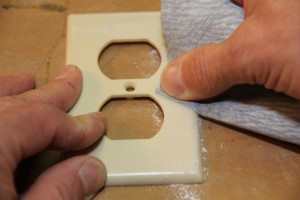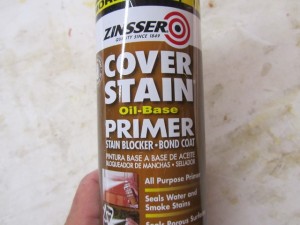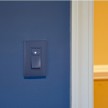How To Paint Electrical Switch Plates
How To Paint Electrical Switch Plates
Match Your Electrical Switch And Outlet Plates To Your Wall Color. This article will explain the proper techniques and “Tips” for Painting Electrical Plates Introduction.
Many homes have white or beige outlet and switch cover. This can be unattractive when your walls are painted a color. Who wants a glaring white plastic switch plate as the focal point of a beautifully bright or deeply colored décor?
Almost any wall plate can be painted, even your thermostat. Paint them ~ but do it right!
Detailed below step by step are the necessary functions needed to paint your outlet and switch plates and have quality end result.
Improper techniques can lead to your paint finish to bubble, peel or chip and look awful!
Safety Information
It is very likely that you will be using spray paint. It is important to provide excellent ventilation [fan] and too ALWAYS wear a respirator.
Safety Warnings

1. Always read the labels, as many
oil paints, stains, lacquers and varnishes are extremely toxic.
2. Keep out of reach of children.
3. For your own safety, always work in ventilated areas. Allow fresh air to circulate.
4. Wear protective gear, including gloves, eyewear and respirators. Always use appropriate protective gear on all exposed body areas, especially the hands and eyes.
5. Leave the working environment regularly to access fresh air.
6. Many products are highly flammable and combustible, so NEVER WORK NEAR HEAT SOURCES and DO NOT SMOKE while working with these products.
7. All solvents should be properly

disposed of at your local facility.
8. Vapors are harmful. They may affect the brain or nervous system causing dizziness, headache or nausea. Reports have associated repeated and prolonged occupational overexposure to solvents with permanent brain and nervous system damage. Always follow manufacturers suggested use found on all labels.
9. Rag disposal: Soak soiled rags and waste immediately after use in a water-filled closed metal container.
10. Oil / Alkyd based products: Paints, primers, varnish and stains. These products contain petroleum solvents. Keep away from heat and flame. Avoid breathing vapors or spray mist by opening doors and windows or use other means to ensure fresh air entry during application and drying. If you experience headaches, eye watering or dizziness, increase fresh air or wear a respirator (NIOSH/Msha TC 23C or equivalent) or leave the area. Avoid contact with skin. Do not smoke or use near open flame.
Inexpensive respirators cost approximately $26.00 at your hardware store.
I recommend a NIOSH/MSHA TC-23C-1614 approved respirator thsat will protect you from organic vapors, paint fumes, pesticides, dusts and mists.
What You Will Need For This Project:
For this project there are several different tools that you can use to correctly learn how To paint electrical switch plates.
1. 220 Grit Sand Paper
2. Zinsser cover Stain Oil Based Primer – spray paint
3. Paint brush
4. Piece of cardboard
5. Flat head screw driver
6. Electric wall plate covers and screws
7. Wall paint – colored
Common Errors:
1. Not sanding prior to priming.
2. Skipping the priming step.
3. Not cleaning the dust off the covers prior to priming or painting.
4. Painting the electrical switch or outlet.
5. Not allowing your primer or paint to properly dry.

6. Sanding or painting the wall plate while attached to the wall.
Choose a location to paint these wall covers. Lay a tarp on a table or floor.Preparation:
TIP – cut open a large cardboard box and use that as your work area as well as to control over spray from your spray can.
1. Remove all of your wall plates, including telephone and cable plates. Thermostats can be painted as well. Use a screw driver to do this.
Not removing the plate from the wall is a rookie move and will not result in a professional, quality job. Plus you risk getting paint into the switch or outlet mechanism.

TIP – If you’re not painting the screws put them back into their place in the outlet or keep them safe in a plastic bag for retrieval later.
2. Lightly sand the surfaces of the wall plates with 22 grit sand paper. Sand the entire surface that is seen when the plate is on the wall – including the edges.
3. Sanding is important to de-gloss the plastic and create etching so the primer adheres well. Skipping this step may cause your paint to prematurely fail.
4. Wipe with a damp cloth, tack cloth or wash the plates after sanding to remove sanding dust.
5. Clean area and prepare for priming. Failure to do this step will result in bumps and bubbles under your primer.

Priming:
Using oil based spray primer spray all of the plates until completely coated. Do not skip priming as your paint may not adhere properly or cover well.
1. Work in a ventilated area.
2. Shake the can well before using – shake the can throughout this operation.
3. Hold the can 8 to 10 inches away from the wall plates.
4. Spray in an area that the primer “overspray” will not damage anything. Use a cardboard box to contain overspray
5. Moving the can back and forth apply the primer smoothly and evenly.
6. Avoid over spraying and causing drips or runs in the primer.
 7. After the primer has dried you may apply a second coat if you did not achieve complete coverage. Several thin coats ALWAYS is better than a thick coat – prevents drips!
7. After the primer has dried you may apply a second coat if you did not achieve complete coverage. Several thin coats ALWAYS is better than a thick coat – prevents drips!
TIP – Don’t spray too close or too much!
TIP – Test your spray can on some cardboard to learn how the primer comes out. Sometimes new nozzles sputter when they start out and need a few seconds of spray testing prior to going to work.
8. Allow the primer to dry according to manufacturers recommendations. Failure to wait for the primer to properly dry may cause your paint to fail.
Sanding Between Coats:
If you’re looking for perfection I recommend sanding between your primer and finish coat.
 1. Use 200 to lightly sand the wall plates. Focus on removing any bumps or bubbles.
1. Use 200 to lightly sand the wall plates. Focus on removing any bumps or bubbles.
2. Sand in once direction and don’t sand too aggressively of scratches will be visible through the top paint coat.
3. Wipe or clean the wall plate after sanding to remove any sanding dust. Failure to do this step will result in bumps and bubbles under your paint.
How To Paint Electrical Switch Plates: Painting
1. Using a quality paint brush apply paint to the wall plate.
2. If holding the plate – paint the edges first.
3. Apply only as much paint is needed to cover completely and evenly.
 4. Apply paint to the entire wall plate. When you have the wall plate completely covered in paint finish off with long, smooth, brush strokes in the same direction.
4. Apply paint to the entire wall plate. When you have the wall plate completely covered in paint finish off with long, smooth, brush strokes in the same direction.
5. Brush from one end of the cover to the other side.
TIP – Do not paint the actual switch or outlet. Getting paint into an electrical mechanism can be dangerous and may interfere with the proper function of the electrical component.
6. Wipe up any drips with your brush or a rag.
7. Carefully place the wall plate cover down to dry.
TIP – If you leave finger prints while placing the cover down simple take your brush and lightly brush from one end to the other to eliminate the print.
 8. Allow to dry
8. Allow to dry
9. If additional color coverage is needed you can lightly sand this coat, remove dust, and apply a second in the same fashion.
10. Allow to dry 24 hours before mounting to the wall.
Painting The Screws:
Painting the screws is easy. To do this you will need a section of cardboard box or Styrofoam.
1. Place all of the screws threads first into the cardboard or Styrofoam, leaving the screw head exposed.
2. Space the screws approximately 1” apart.
 3. Lightly sand the screw head
3. Lightly sand the screw head
4. Remove dust
5. Apply primer
6. Let dry
7. Apply colored paint
8. Let dry.










